National Environment Management Authority - NEMA is the National Implementing Entity- NIE for Adaptation Fund in Kenya. The Adaptation Fund was established under the Kyoto Protocol of the UN Framework Convention on Climate Change to finance concrete adaptation projects and programmes that help vulnerable communities in developing countries. Climate Change has contributed to worsening food security, reduced the predictable availability of fresh water, and exacerbated the spread of disease and other threats to human health.
The Adaptation funds are committed towards building resilience among vulnerable communities who are susceptible to the adverse impacts of climate change. NEMA is currently implementing an adaptation programme titled “Integrated Programme to Build Resilience to Climate Change and Adaptive Capacity of Vulnerable communities in Kenya” The programme has 3 Executing Entities and 7 sub-Executing Entities as follows: Coast Development Authority (CDA), Kenya Forestry Research Institute (KEFRI), Tana and Athi River Development Authority (TARDA), NASARU CBO, Victoria Institute for Research on Environment and Development (VIRED) International, Kenya Red Cross Society(KRCS), Horn Aid Kenya(HAK), Adventist Development and Relief Agency (ADRA), Kenyatta University (KU) and CARITAS Nyeri. The programme is located in 15 Counties across the country namely: Kilifi, Kwale, Taita Taveta, Kisumu, Marsabit, Laikipia, Garissa, Wajir, Kajiado, Kitui, Makueni, Machakos, Muranga, Nyeri and Embu. The programme thematic areas include water management, food security, agro forestry, coastal and mangrove ecosystems and disaster risk reduction.
NEMA board of management undertook a monitoring exercise in Embu, Machakos, Laikipia, Kajiado and Kwale Counties to assess the project activity status and success.
Machanga Earth Dam in Embu county
Machanga earth dam has a capacity of 35,000 cubic liters and harvests surface water run-off. Water security has been enhanced among the neighboring community by building community resilience to climate change water induced stress. The water serves 1200 community members from four villages namely: Ngongo, Murambare, Mukarore and Gethiorore vilages. Water is used for irrigation, domestic use and animals drinking. Farmers use water to irrigate their maize, bananas and pawpaw farms. Tana River and Athi Development Authority (TARDA) is the Executing Entity of the project.
During their visit on 20th January 2020, the NEMA board visited the project to assess its status and impact since it's completion in 2016. The local community expressed their gratitude for the project’s as had alleviated the problem of water shortage and they no longer had to fetch water from crocodile infested River Tana. The dam harvests the flood waters, the water is then piped to a watering point for access by the locals for domestic use.

Machanga dam in Embu County
Ngetani smallholder irrigation project Machakos County
Ngetani smallholder irrigation project in Masinga supplies piped water to over 80 households for domestic and irrigation purposes. The project has been implemented by NEMA in collaboration with TARDA with funding from the Adaptation Fund. The project has enhanced food and water security.
Kenyatta University through Adaptation Fund drilled and equipped a borehole at Vota Primary School in Machakos County. The borehole supplies water to the water-scarce area improving the community's livelihoods. The borehole is yields 40 cubic meters of water per hour. This water is being used by over 15 households including locals schools and other neighboring public institutions.
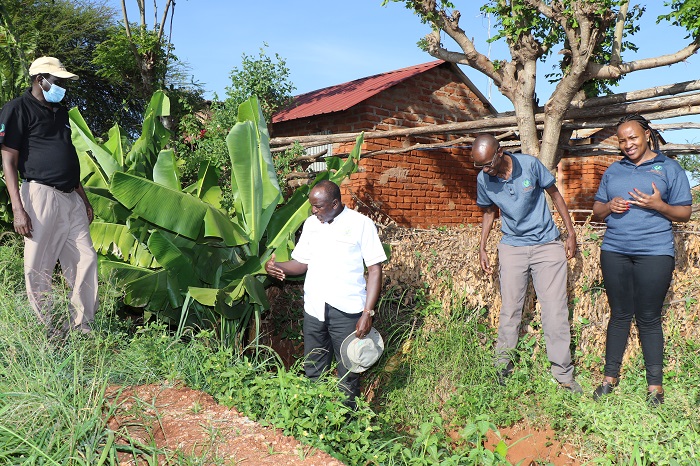
NEMA Board at one of the farms planting bananas using water from the irrigation project
Imbirikani, Kuku, Kimana, Rombo, Lenkisim and Entonet Water pans in Kajiado County
The vast part of Kajiado County is majorly semi-arid. Pastrolism is the main source of livelihood for the predominantly maasai community. The Authority in collaboration with KEFRI has constructed 6 water pans of an average capacity of 18000 cubic meters. The water pans are located in Kajiado South sub county in Imbirikani, Kuku, Kimana, Rombo, Lenkisim and Entonet locations.
The water pans serve hundreds of cattle per day. Mzee Lemashon herds his cattle to Entonet water pan explains that the water pan has been of great help to the locals. “We used to walk for a long distance during the dry season to find water for our animals. But now with this water pan that serves for at least three months before the next rainy season is able to feed our animals at ease,” Lemashon states pointing to tens of cattle’s drinking water at the pan.
At Kimana, their only source of water used to dry up soon after the rain stopped. But with tapping of the spring water and flood water, the locals are able to enjoy availability of water throughout the year for their animals and domestic use. The presence of borehole has also boosted the survival rate of grass for their animals.
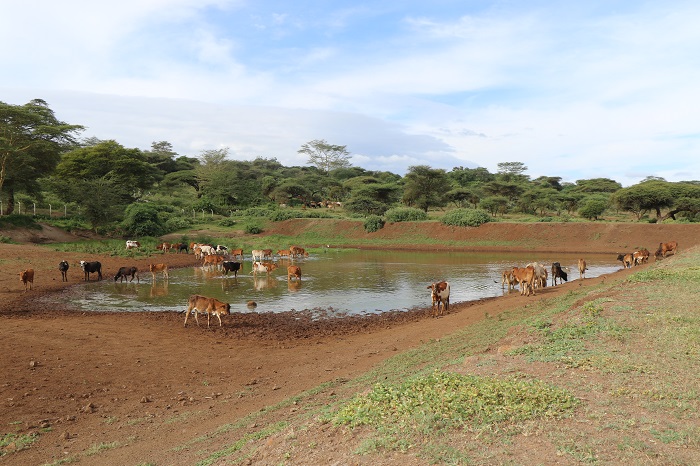
Cows drinking water from Kimana water pan

NEMA Board at the Imbikikana water pan with locals and officials from KEFRI
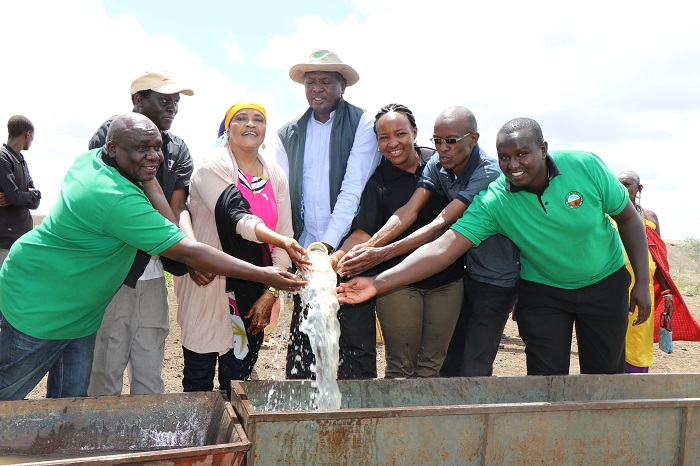
NEMA Board with officials from KEFRI holding a pipe draining water from Entonet water pan
Thome Small holder Irrigation Scheme and Adaptation village in Laikipia County
Located on the leeward side of Mount Kenya, most parts of Laikipia County is mainly dry and features Arid and Semi-Arid (ASAL) vegetation. The locals experience low rainfall and have inadequate water supply.
As a result of this, NEMA in collaboration with Caritas Kenya identified Thome area in the County as one of the beneficiary of the Adaptation Fund programme. The ongoing Thome smallholder irrigation project harvests water from the overflow water of river Naromoru, that is channeled through gravity to a 25 000 cubic liters’ water pan. Three storage tanks of 225m3 capacity masonry tanks have been constructed.
An Adaptation village will be established in Leshugu secondary school and borehole with a yield capacity of 40 cubic liters per hour of water has been drilled. In addition, a watering point and a learning center on sustainable use of water is under way. An Adaptation village is concept for delivering water security and social transformation and is composed of a solarized borehole, community water points, training hall, demo plot and a sanitation facility.
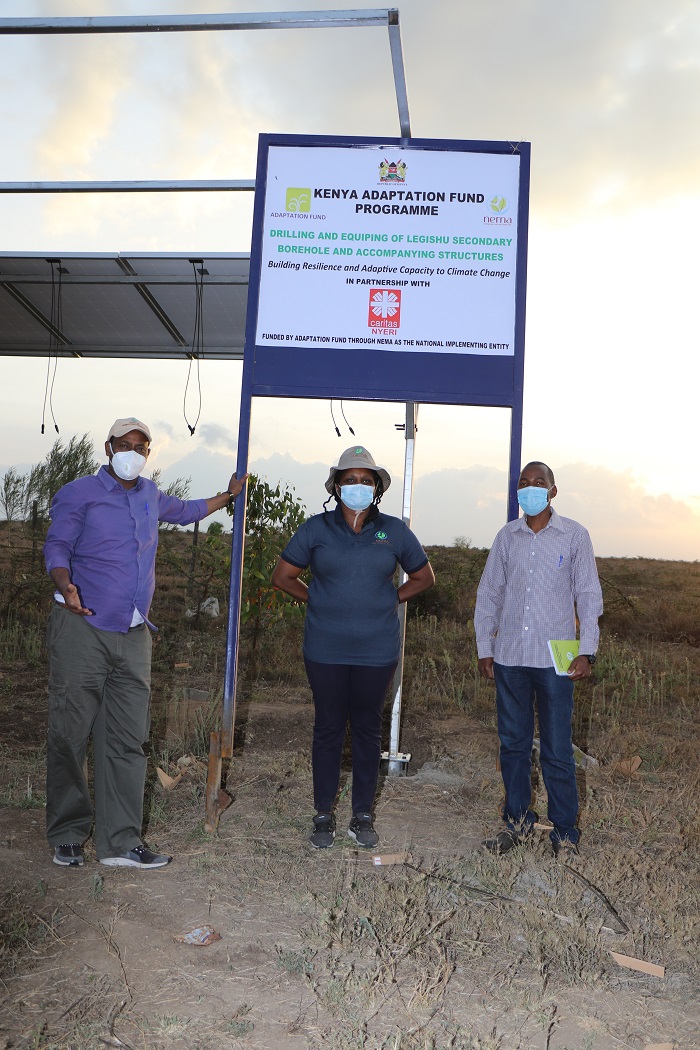
NEMA DG Mamo B. Mamo (L) with NIE Coordinator Wangare Kirumba and Programme Coordinator John Wafula at Legishu Secondary School in Thome
Coral reef and sea grass restoration in Kwale County
The Authority in collaboration with Coastal Development Authority (CDA) is implementing an Integrated Shoreline and Mangrove Ecosystem Management (ISMEM) project in Kwale county. The project has grown over 170,000 Mangrove seedlings in, over restored over 2 kilometers of coral reef in Wasini Island and a National Coral Reef Restoration Protocol developed. Wasini Beach Management Unit (BMU) is a group of youth and women spearheading the rehabilitation of the degraded coral reefs. Climate change and human activities such as poor waste management, illegal fishing methods and degradation of Mangroves ecosystem have contributed greatly to the loss of the marine ecosystem. A healthy coral reef provides habitat and breeding sites for various species of aquatic animals.
The Wasini Beach Management Unit -BMU Chairman, Mohammed Ahmed, observed the coral reef restoration had benefited the fisher folk as the fish stocks had improved by over 80%. The community identified the lack of adequate office space, lack electricity, lack of freezing facilities and inadequate fresh water as the challenges they are facing.
The Coastal Development Authority (CDA) Managing Director Dr. Mohamed Keynan described the project as a success story with unique achievements as it was community driven initiative. He expressed gratitude to NEMA for it support. The Wasini Beach Management Youth Group was awarded a second position in the category of Innovation in Youth Empowerment. Food security had been achieved as a result of increased fish production. Seagrass restoration was ongoing. The seagrass led to the stabilization of the seabed and contributed greatly to carbon sequestration. The MD added that CDA plans to share the knowledge and lessons learnt on Integrated Shoreline and Mangrove Ecosystem Management with the neighboring counties for replication. The Vice Chair of the NEMA Board, Prof. Peninah Aloo-Obudho congratulated the Wasini Beach Management Unit and CDA for a job well done. She commended the enthusiasm of the community driven initiatives and overall success of the project.
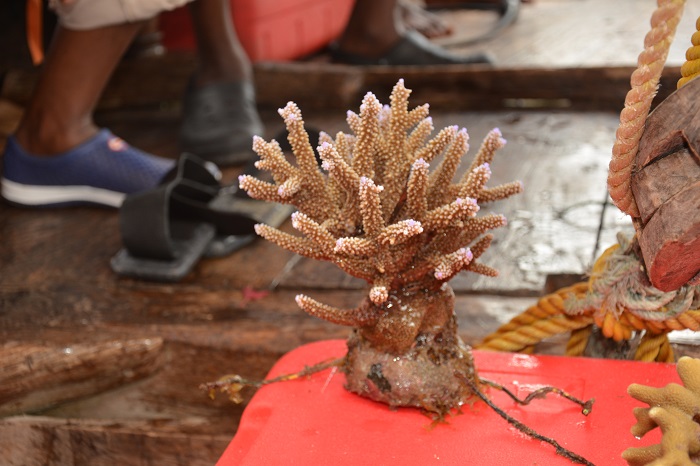
Artificial coral reef




 Popo Road,South C, off Mombasa Road
Popo Road,South C, off Mombasa Road P.O.BOX 67839-00200, Nairobi. Kenya
P.O.BOX 67839-00200, Nairobi. Kenya Mobile: 0724 253398, 0735 013046.
Mobile: 0724 253398, 0735 013046. Email: info@nema.go.ke
Email: info@nema.go.ke